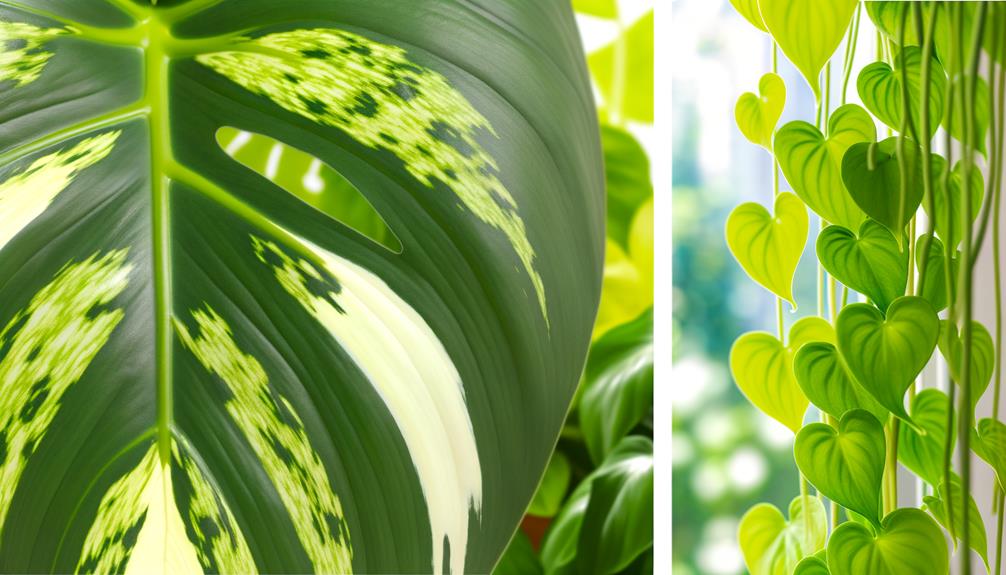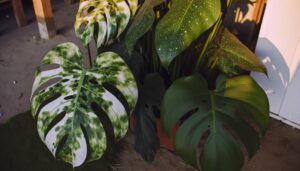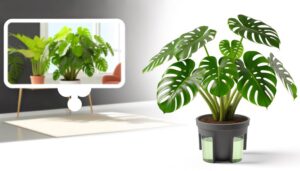Differences Between Monstera Deliciosa Variegata and Pothos?
Monstera deliciosa variegata and Pothos (Epipremnum aureum) differ primarily in leaf morphology and growth habits. Monstera has large, fenestrated, variegated leaves with white or cream patches, while Pothos displays smaller, heart-shaped leaves with variegation in yellow, white, or light green, lacking perforations.
Monstera climbs using aerial roots and thrives in high humidity, whereas Pothos can either trail or climb and adapts to varied environments, tolerating lower humidity. Monstera, native to Central America, prefers consistently moist soil, while Pothos, from the Solomon Islands, needs its soil to dry out between waterings.
There's more detailed information to discover.

Key Takeaways
- Monstera deliciosa variegata has large, fenestrated leaves, while Pothos leaves are smaller, heart-shaped, and lack holes.
- Monstera grows as a climbing vine with aerial roots, whereas Pothos can both trail and climb.
- Monstera prefers bright, indirect light and high humidity; Pothos can tolerate lower light and average household humidity.
- Monstera needs consistently moist soil; Pothos prefers the soil to dry out between waterings.
- Monstera is native to Central American rainforests; Pothos originates from the Solomon Islands.
Appearance
How do the Monstera deliciosa variegata and Pothos differ in appearance?
First, Monstera deliciosa variegata, known for its striking variegated leaves, has large, glossy, fenestrated leaves with white or cream-colored patches. The fenestrations, or natural holes, give it a unique, perforated look.
On the other hand, Pothos, scientifically named Epipremnum aureum, has heart-shaped leaves that are generally smaller, with variegation patterns in yellow, white, or light green. Pothos leaves are smooth-edged and lack the fenestrations seen in Monstera.
Additionally, Monstera's leaves tend to be larger and more robust, whereas Pothos leaves are more delicate and flexible. This distinct foliage difference makes identification straightforward when comparing these two popular houseplants.
Growth Habits
In addition to their distinct appearances, Monstera deliciosa variegata and Epipremnum aureum exhibit markedly different growth habits, with Monstera typically growing as a climbing vine that can reach several feet in height, while Pothos thrives as a trailing or climbing plant with a more moderate growth rate. Monstera deliciosa variegata grows robustly, attaching to supports using aerial roots. In contrast, Epipremnum aureum, commonly known as Pothos, grows slower but adapts well to various environments, either climbing with aerial roots or trailing gracefully.
Here's a quick comparison:
| Plant Type | Growth Habit | Maximum Height/Length |
|---|---|---|
| Monstera deliciosa variegata | Climbing Vine | Several Feet |
| Epipremnum aureum (Pothos) | Trailing/Climbing | Moderate Length |
| Aerial Roots | Yes | Yes |
Understanding these differences helps you choose the right plant for your space.
Care Requirements
Although both Monstera deliciosa variegata and Epipremnum aureum (Pothos) are relatively low-maintenance, each species has distinct care requirements that promote ideal growth.
- Light: Monstera deliciosa variegata prefers bright, indirect light to maintain its variegation, whereas Epipremnum aureum can tolerate lower light conditions but thrives in medium to bright indirect light.
- Watering: Monstera deliciosa variegata requires moderate watering; keep the soil consistently moist but not waterlogged. Pothos, on the other hand, is more drought-tolerant and prefers its soil to dry out between waterings.
- Humidity: Monstera deliciosa variegata benefits from higher humidity levels (60-80%), while Pothos is more adaptable and can thrive in average household humidity (40-60%).
Following these guidelines, each plant flourishes in your care.
Origins
Understanding the origins of Monstera deliciosa variegata and Epipremnum aureum (Pothos) provides valuable insights into their unique characteristics and care needs. Monstera deliciosa variegata, native to the tropical rainforests of Central America, thrives in high humidity and indirect sunlight. Epipremnum aureum, commonly known as Pothos, originates from the Solomon Islands but has naturalized in various tropical regions globally.
| Plant | Scientific Name | Native Habitat |
|---|---|---|
| Monstera deliciosa variegata | Monstera deliciosa | Central American rainforests |
| Pothos | Epipremnum aureum | Solomon Islands |
Both species exhibit adaptations to their specific environments, influencing their growth patterns and care requirements. Monstera deliciosa variegata's large, fenestrated leaves contrast with Pothos' smaller, heart-shaped foliage, reflecting their distinct ecological niches.
Ideal Environments
Monstera deliciosa variegata thrives in environments with high humidity levels, indirect sunlight, and well-draining soil. This plant requires relative humidity above 60% to thrive. To prevent variegation loss, it prefers bright, indirect light. When it comes to soil, Monstera needs well-draining, aerated soil rich in organic matter.
Pothos (Epipremnum aureum), on the other hand, excels in a wider range of conditions. It can tolerate lower light levels and moderate humidity. Pothos can thrive in relative humidity levels as low as 40%. While it can adapt to low light, Pothos grows best in medium to bright indirect light. For soil, Pothos is less selective and can thrive in standard potting mix.
To create the ideal environment for both Monstera and Pothos, consider these key factors: Humidity, Light, and Soil. Understanding and meeting these conditions will guarantee that both plants flourish.
Conclusion
In comparing Monstera deliciosa variegata and Epipremnum aureum (pothos), you've explored their distinct appearances, growth habits, and care needs.
Can you now envision the vibrant, variegated leaves of Monstera contrasting with the hardy, cascading vines of pothos?
Both, hailing from different tropical origins, thrive in specific environments.
Mastering their care isn't just about nurturing plants; it's about understanding their unique botanical identities.
So, which one will you cultivate to transform your space?






